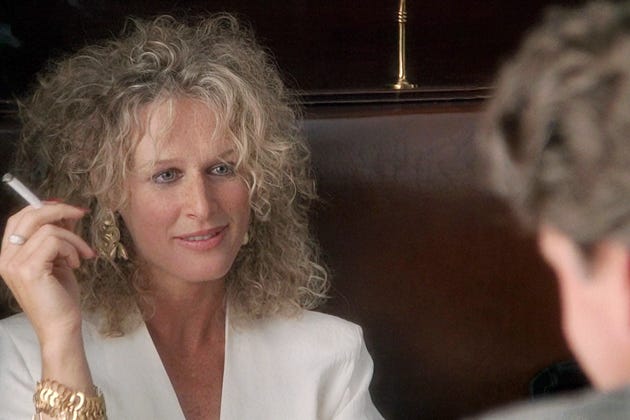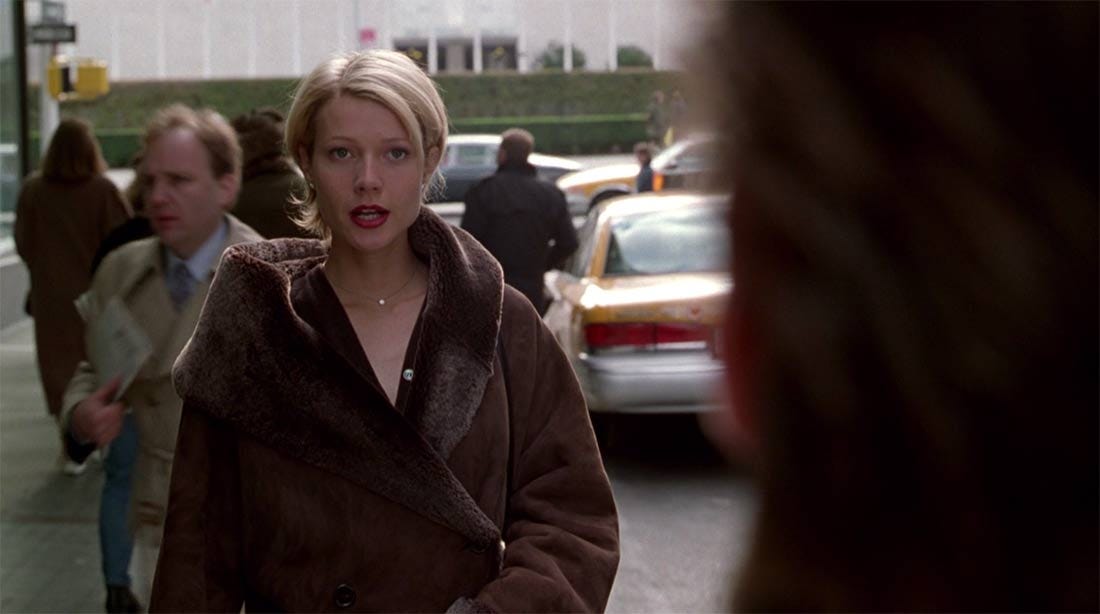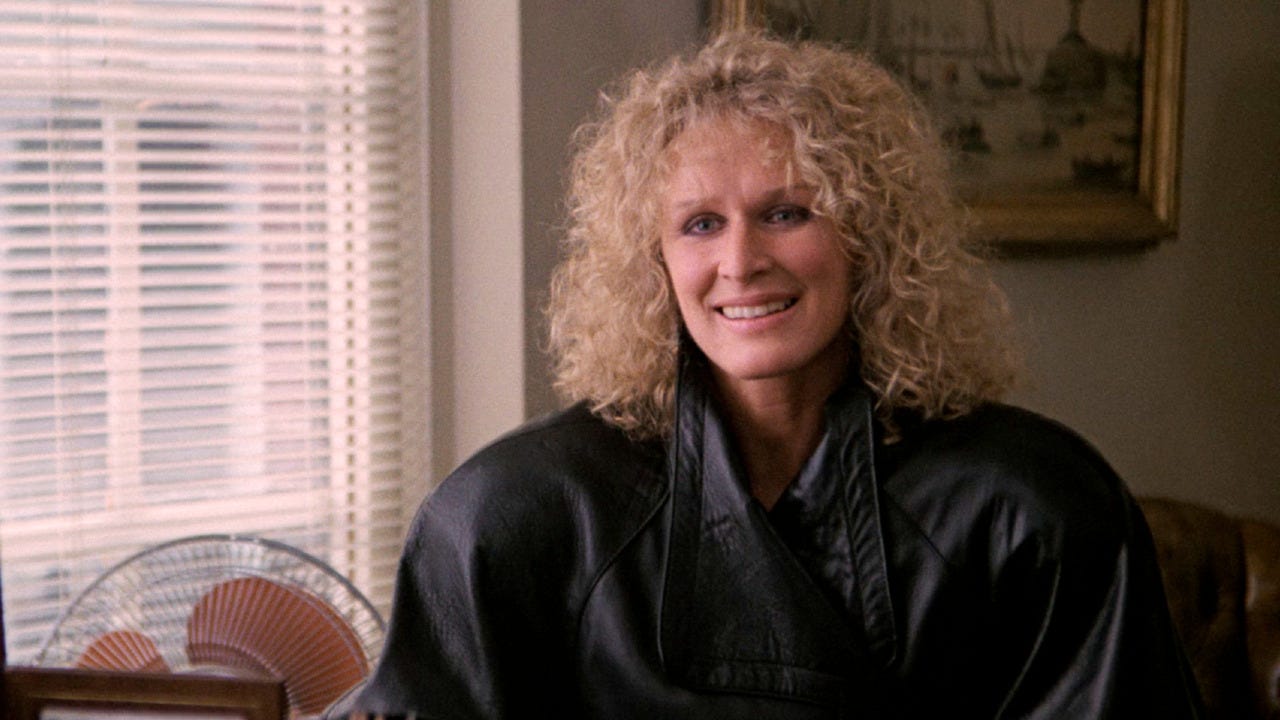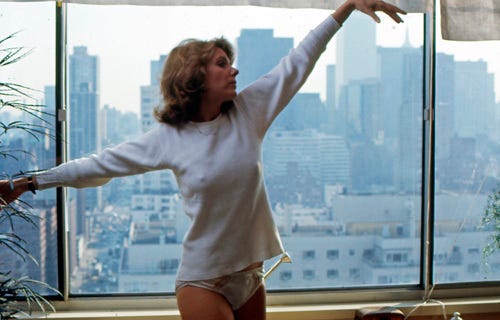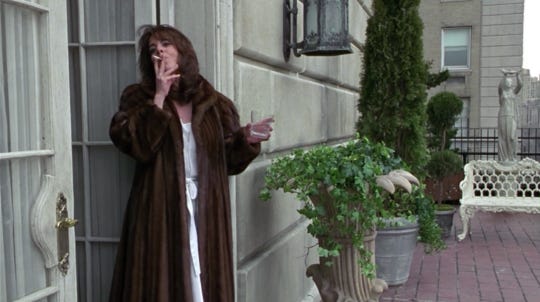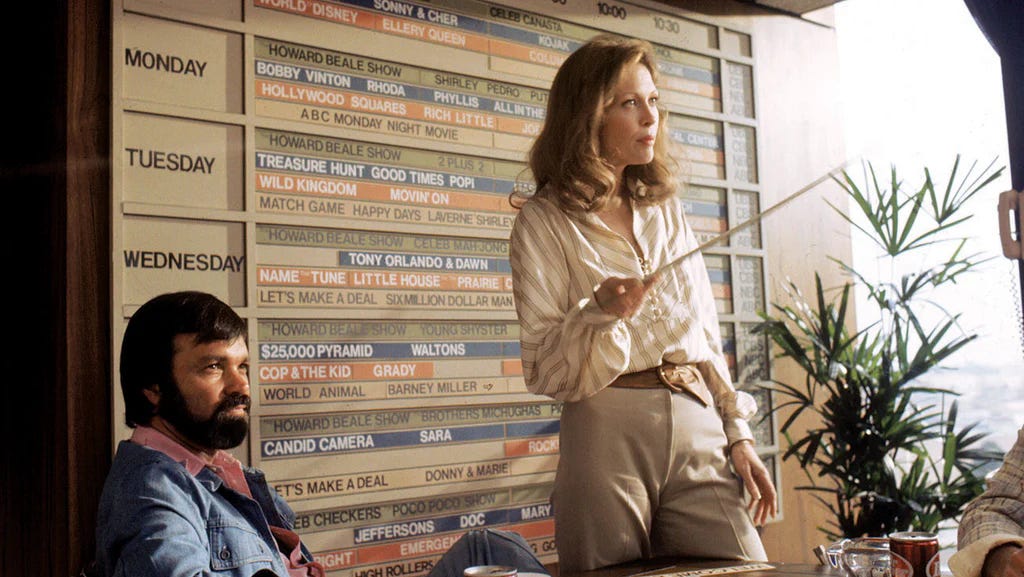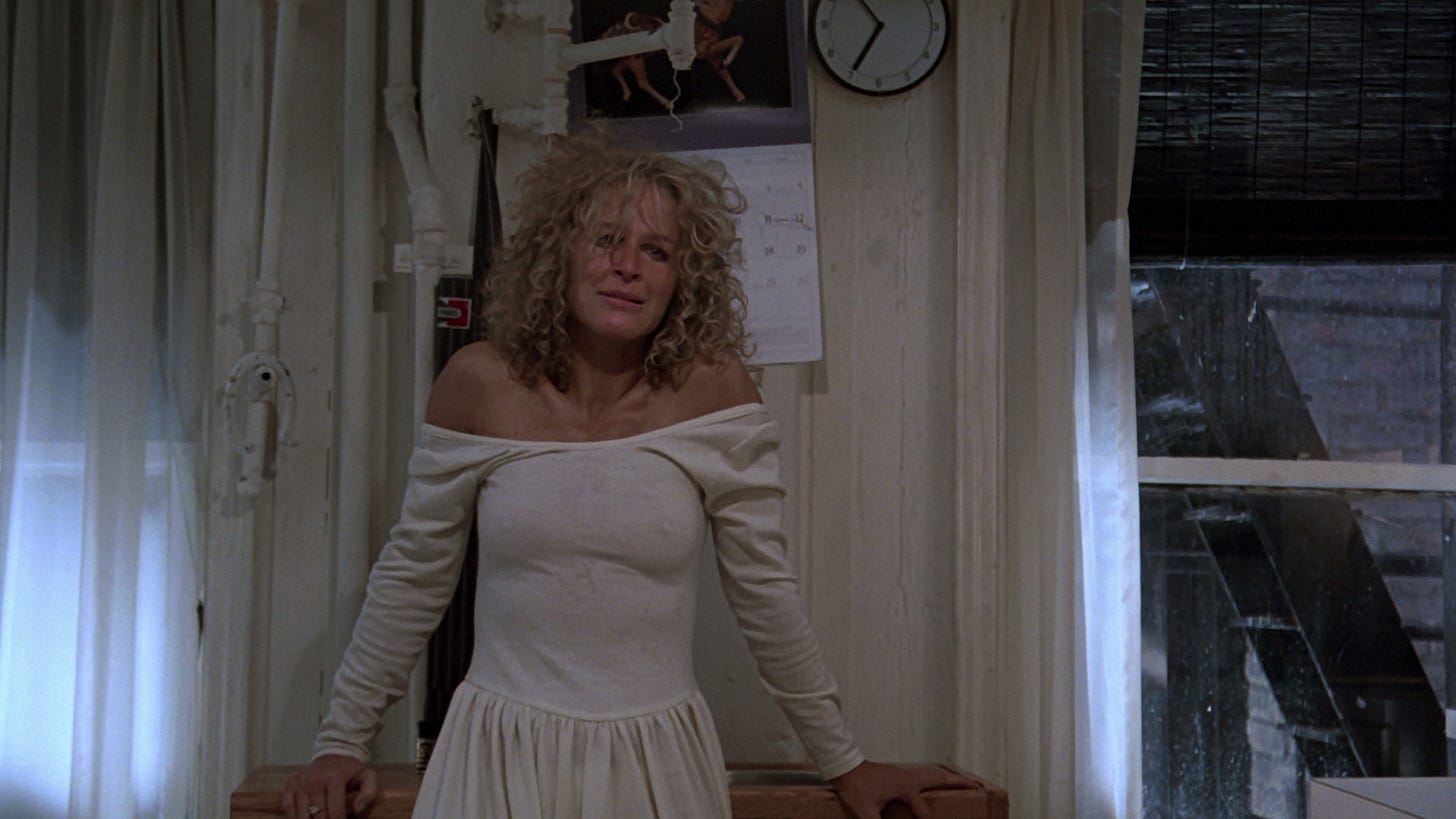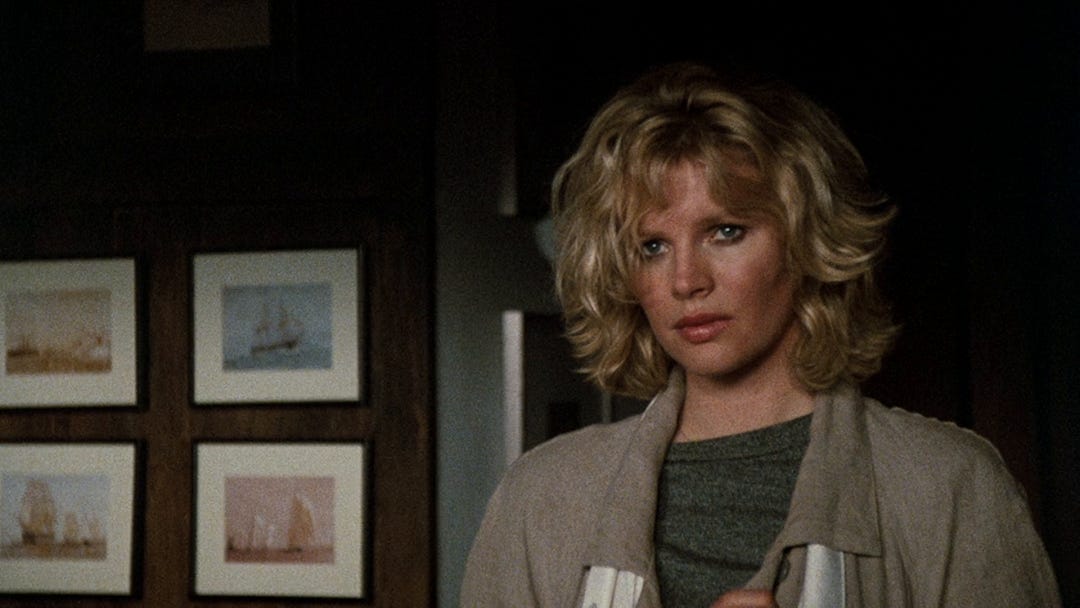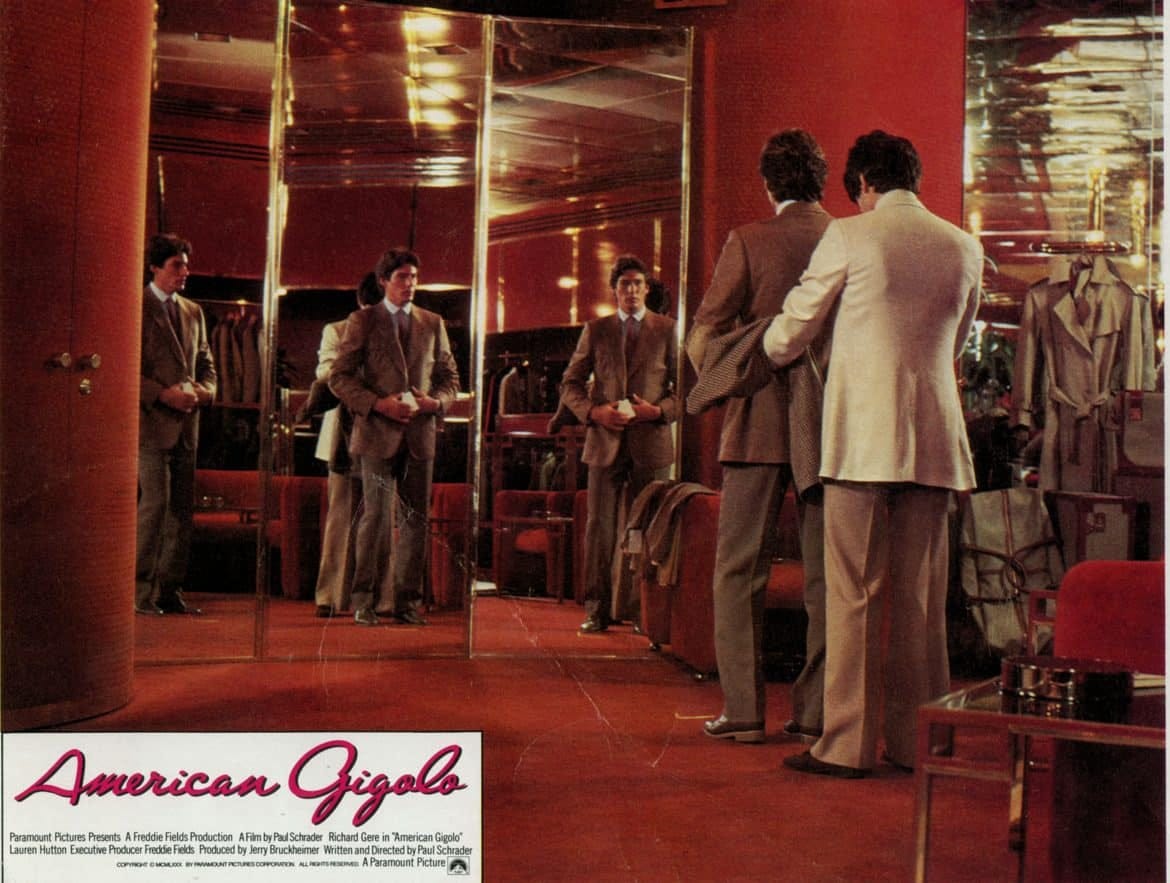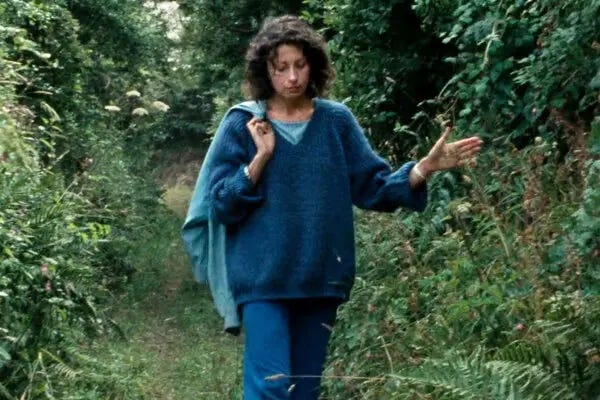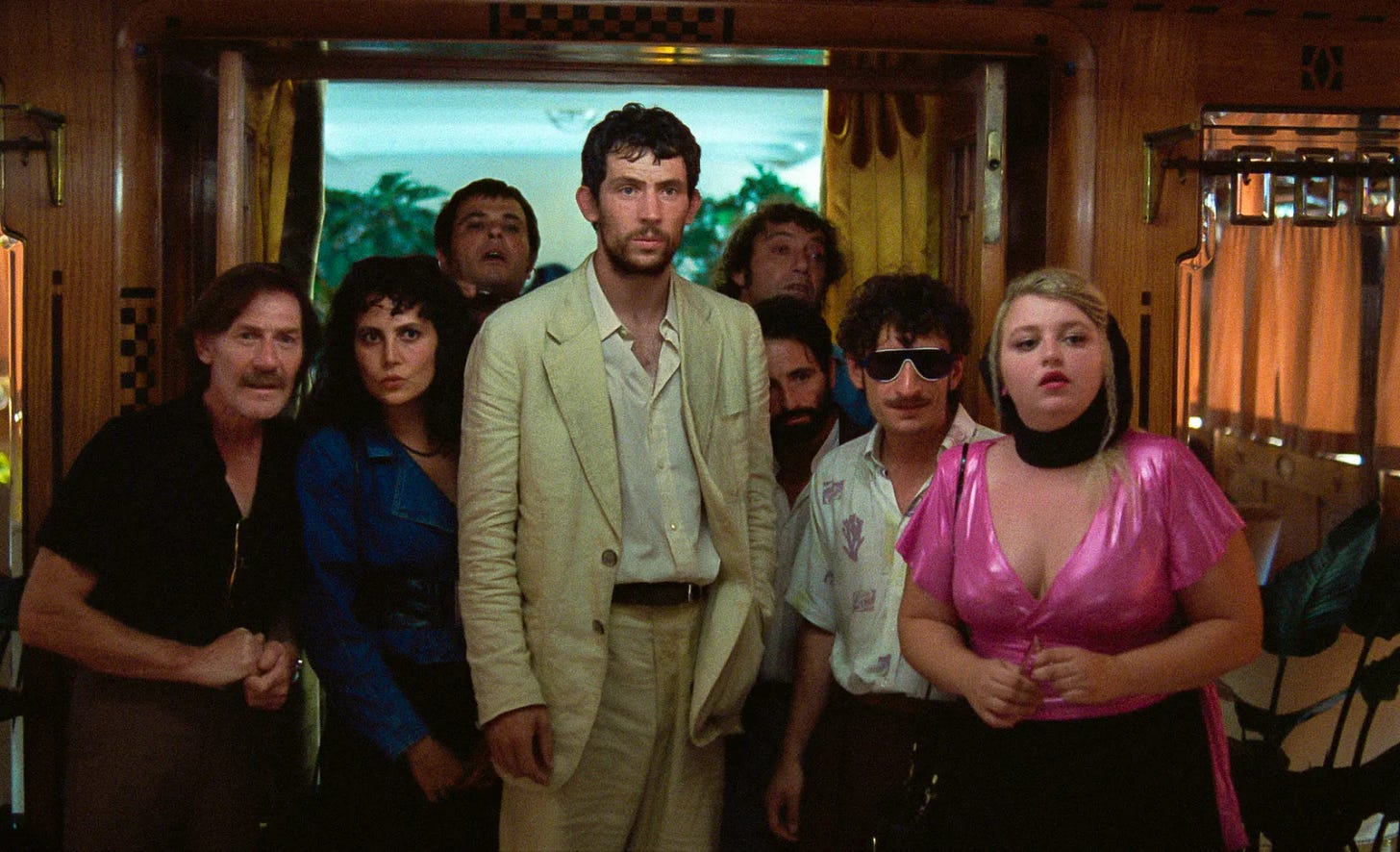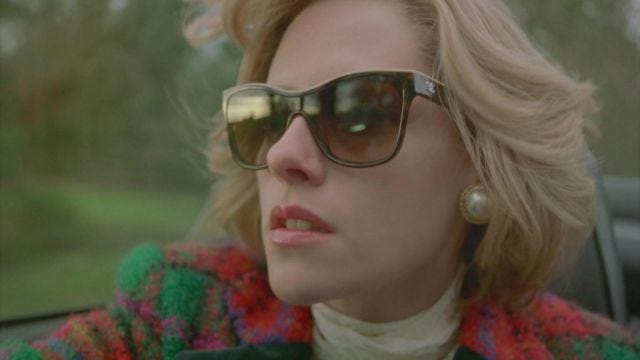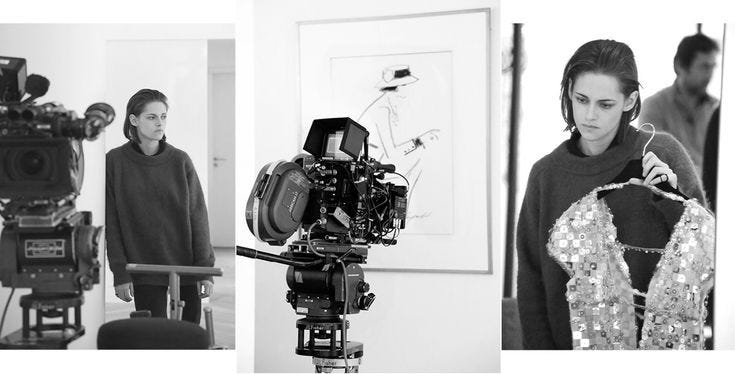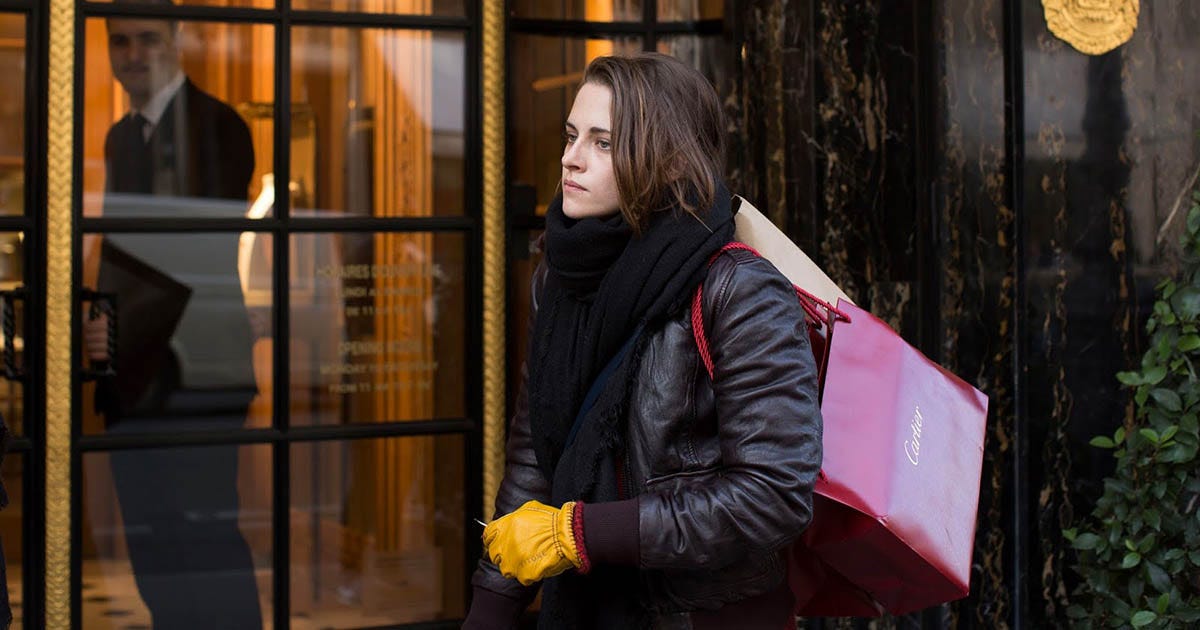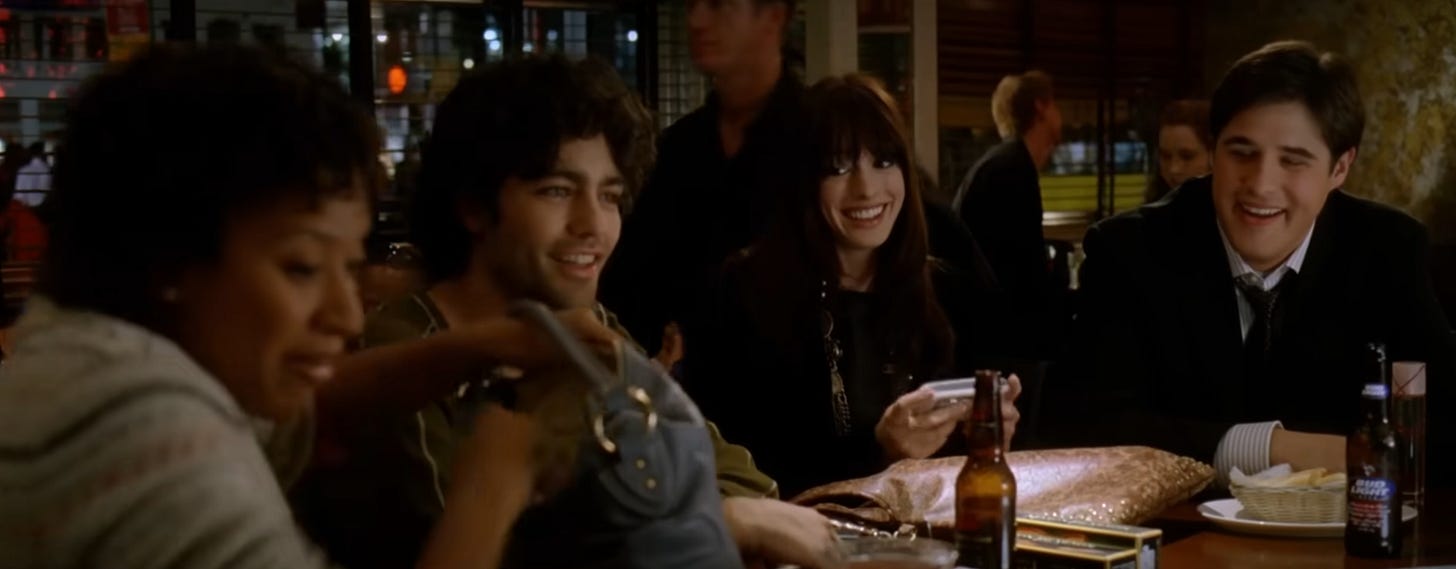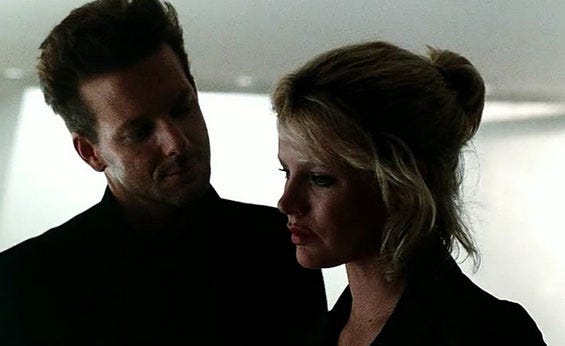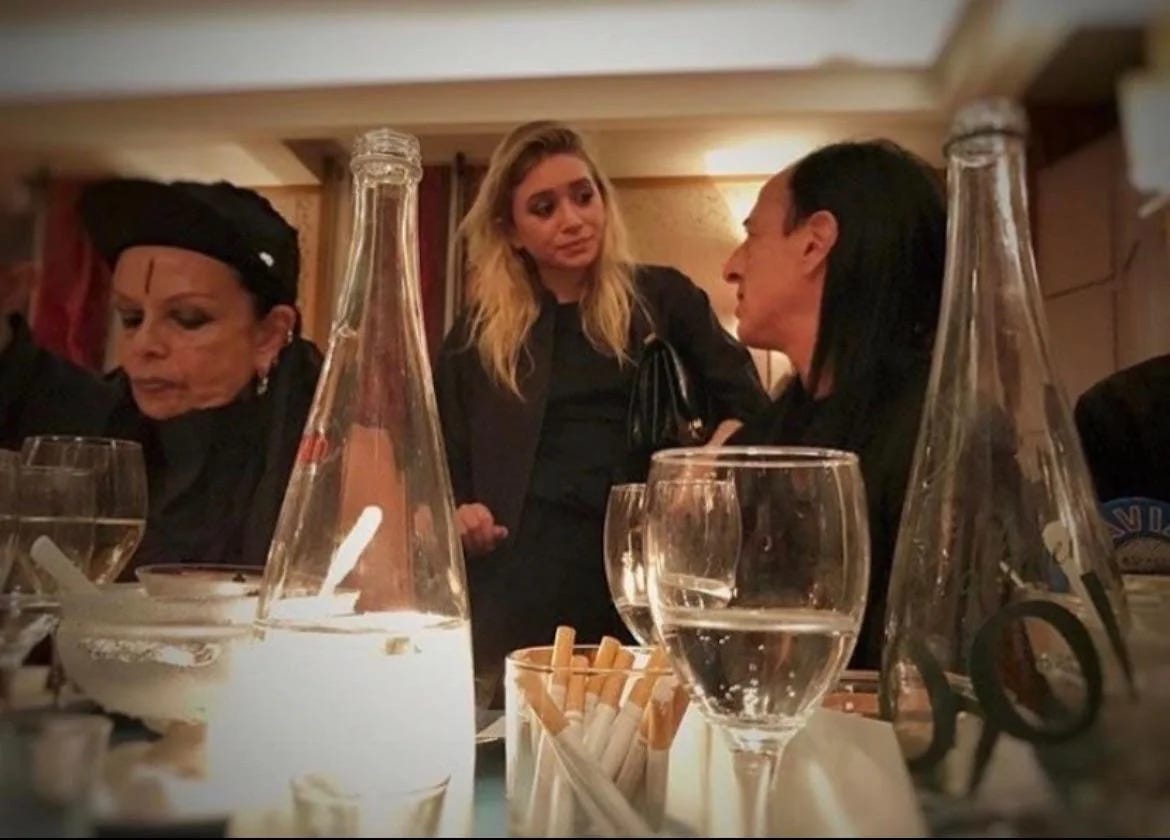Dressing the part
“Actors don’t have real teeth anymore.”
Colleen Kelsey is a writer and creative director based in New York. Her work has appeared in i-D, The Whitney Review, Dirt and T Magazine. As a creative director and copywriter, she’s worked with brands like CHANEL, Equinox and Glossier.
Before we get into it, some gems didn’t make it into the final cut. (Colleen and I spoke for 3 hours!) And while I know we’re all tired of recommendation culture, especially around this time of year, here’s my one contribution (thanks to her): Office Killer – the only film Cindy Sherman ever directed. Read on for more on working women, costume design and Buzz Bissinger’s Gucci addiction.
What have you been watching or rewatching lately?
I've been very much in the headspace of the New York working woman. I suppose I am her, but who is she? What is she wearing, and how is she appearing on film? I took some notes and pulled some images. All this feels seasonally appropriate and evergreen. And then there's the trajectory of: where else is she going?
And also where is she going in terms of class mobility? In terms of older movies especially: is she getting that husband? Is she getting saved from her situation? There’s this movie with Barbara Stanwyck called Babyface. It's very saucy. She's basically living in the middle of nowhere and working as a barmaid for her father. Then she leaves town and goes to New York where she starts working at a company. To ascend, she has to go through a man until she finally stops working. And when she does, she goes from her suit to furs. And that’s when stuff starts happening.
But that’s one aspect. For some reason, I’m also very obsessed with every Adrian Lyne movie that has that woman who is working in New York and is dressed in a very stylish but normal way. Fatal Attraction comes to mind. It's such an intense portrayal, though she kind of has it all. She's a very important publishing executive who has amazing clothes. It’s all about the coats and the cream suiting — another Adrian Lyne thing. This is before, you know, all the crazy.
So what’s in the working woman’s closet? Or how does her life influence what she wears? What does she look like?
The real life question is so important because of the day-to-evening thing – especially for the working woman. Everyone has to at some point. I’m usually carrying around 3 tote bags to achieve all of this because I'm going to the office, then if I'm doing something after, well, do I have the right bag? Do I have the right clothes? Do I have shoes? Do I have makeup? Am I putting things in my desk, which is something that I used to do when I was more regularly in an office, and not hot desking or whatever. And at times, you have to be like, well, I'm wearing this dress, and I can take my sweater off to go to this thing. Or I’m going home and changing. Or I’m not thinking about it at all. But it's very much like that: what are our lives?
And then – who are these characters in a film? What are they like, what feels naturalistic? That’s what’s usually the most interesting, I think. And the job detail is so funny because with all these working girl movies or these movies about women in cities – what are their jobs exactly? This woman is a book editor or she works at a gallery, or she’s a UN translator like Gwyneth Paltrow in A Perfect Murder.
Or what happens to this woman’s wardrobe when she re-enters the workforce?
Like in An Unmarried Woman, where she’s getting divorced, and she’s now focusing on her career. Or, focusing on being out in the dating pool – another challenge. Or it’s Faye Dunaway in Network. I guess the look is “Dress for Success.” The big gray suit. Or head to toe in brown. The power suit. The power moves.
I think back to Fatal Attraction again, when Glenn Close arrives at his office unannounced and she's wearing that big black leather jacket. It's so funny to me because your reaction is supposed to be one of fear. She's showing up where she doesn't belong and is essentially intimidating. It’s a confrontation because he won’t take her calls. It's supposed to be this moment of anxiety and horror, and yet, she looks so amazing. So how do we feel about it?
There’s not a lot of colour in the corporate world unless you’re at the top of the food chain.
Right. Unless you're the big boss and have the laurels to do anything. Because it can announce your character in such an intense way.
The use of these muted colours and neutrals, especially in Fatal Attraction, is interesting because it offsets the terror and chaos. All these notably peaceful tones are a great way to contrast her interior.
There’s that final scene where she wears that white knit dress, which feels so completely antithetical to a villainous character.
And the other characters I think of – these working women – it’s all about a trench coat for them. Everybody is wearing a trench coat in all of these movies. Kim Basinger in 9½ Weeks. There are moments when she’s very well put together, and other moments where she’s schlubby, in a certain way. There’s a knit underneath the trench or she has this pulled-down, baggy sweater. And that has a certain realism where, you know, she works at a gallery, and she’s schlepping around.
As that relationship intensifies, the clothing gets more prescriptive or official. There’s a parallel, in a way, when you watch Working Girl, and you see Melanie Griffith clean up. But I think the more interesting clothes are when she's supposed to be tacky at the beginning.
The big hair.
The big hair and the big wool coat. Her super thick, athletic socks with her sneakers. And she loses those interesting personal details once she starts ascending. She starts wearing Sigourney Weaver's stuff.
I remember that with Katharine Parker (Sigourney Weaver), there's always a pop of red somewhere. The other working women are muted or in black, and with her, it’s grey suiting and a pop of red. That’s the differentiation factor that comes with a corner office. Or maybe it signals that she’s a threat: Sigourney’s Katharine Parker has backstabbed and burned bridges on her way to the top.
And there’s also that one big red outfit. And the red lipstick. I think even when she's in the hospital, she's still wearing red lipstick.
The red ski boots too.
It’s her villain coding.
How critical is the costume designer in shaping this working girl? Or making her seem realistic to a viewer?
The perception of the costume designer has shifted. Edith Head or Adrian [Adolph Greenberg] were celebrities in their own right. There’s no question. After that period, it became about designer collaborations, and not in the way that we think of it now: YSL always working with Catherine Deneuve or with specific filmmakers. This was an amazing collaboration between fashion and film.
Then we had more branding integration – the shop to buy – that got more extra, especially around the Sex & the City movies. Like, fashion is so important, but I can also buy the literal Manolos that Carrie’s wearing. Now, it’s like, Jonathan Anderson is walking red carpets with Luca Guadagnino. I don’t know how I feel about that.
It’s less of a collaboration and more like cross-branding, right? Two brands come together onscreen and on the red carpet.
Yeah. It’s the vertical integration of the movie, and it's the ongoing collaboration with Luca, Zendaya, Jonathan Anderson for the Challengers movie. It’s okay. This is a very tangible product. It does feel very different to me than when Luca was collaborating with Raf Simons. That felt more traditional; he was doing the costumes.
Does it feel like a shtick now?
Yeah, and it feels like it’s part of the promo. I’m trying to ignore it but it feels much more like a merchandised product. The Paul Schrader and Armani collaboration for American Gigolo was about suiting, clothing, and character — even though it did influence things in an organic way.
Is it because it feels more intrinsic to the character? Whereas now, it feels less true to life for a character. Like it when it comes to Luca and Jonathan collaborating – it’s less about the characters actually gravitating towards Loewe or Jonathan Anderson. Now it’s a business partnership and part of a press tour at this point.
It's like an arranged marriage. If you talk about American Gigolo, it's like, okay: Julian (Richard Gere) is living in LA in the late 70s. He would conceivably go into Armani or Giorgio Beverly Hills and buy that stuff because he’s obsessed with self-presentation. You see all of his ties and shirts. It feels very much like this is conceivably real. I feel like another reference that people bring up a lot is Gwyneth Paltrow in A Perfect Murder, where she's that rich woman who has that very specific Kelly bag. I know where she lives. I know what she likes. There’s something real about these kinds of styling choices.
Remember Meryl Streep and Roy Schieder in Still of the Night? She's wearing an amazing wool coat. He's a psychiatrist, and what does he have? It's just very basic khakis and button-downs. He has a sweatshirt. But everything is worn-in in the right way. I think he even has an L.L. Bean bag. It seemed like he would. It’s a random kind of movie. I don’t know if it did well, but I enjoy it because it’s an anomaly.
It gets shared on Instagram a lot. I wanted to ask you about how we all dress now because you’ve brought up something interesting. The way movies are styled now is out of touch with the characters. I feel the same way about how real people dress too. People don’t have style; they’ve simply recreated something they’ve seen on Instagram. They put on a different person or character for a day and then move on.
I observe this too. I can't speak from any real encounters but it does feel like there is a divide in terms of: Am I finding my truest self and my identity through a wardrobe? And what is guiding me there? Versus: I just want to try on and throw off as many identities as possible, and be this for one day and then be that for another day. And that’s a larger conversation about consumption and people feeling the need to buy more and get rid of more. There might also be a generational thing of not knowing who you are.
I saw this woman yesterday on the street, and it gave me pause. It was one of the most satisfying things of being out and about and people-watching: seeing what people are wearing is seeing how they inhabit their own style. Maybe you notice something or learn something new or think like, oh, it's so interesting how they're wearing this.
But I saw this woman. First of all, she was walking her perfectly silver Weimaraner dog, which is how I noticed her. She was wearing a very crisp silver trench coat, cowboy boots with a steel toe and a perfect slicked-back bun. And like a seemingly fresh out-the-box short, but not as deep, Birkin bag. I don't know what it's called. To me, this is someone who has been so clearly influenced by social media and is dressing to reflect that back online. And it looks somewhat incongruous on the street in New York. This person wants to be photographed and paparazzied in a way that they probably imagined Carolyn Bessette would, but there's nothing that feels authentic about what they're wearing. It was a weird experience. It’s also how you’ll see someone photographing a pack of girls, and they're all wearing the same outfit.
What’s the tell?
Here’s why it’s always missing the mark: you can tell when someone’s not comfortable.
We’ve been talking a lot about what doesn’t work. But what’s catching your eye? What’s more effective or convincing to you?
Usually, it is something about the actual garment. I was rewatching When Harry Met Sally on a flight recently. And, yes, there's, like, a lot to be said for the state of the sweater. But there's the scene where they're trying to fix up Carrie Fisher with Harry and Sally with the other guy. Meg Ryan is wearing a coat, a leather glove, and this very small box purse. I remember really responding to that outfit. That coat is so great – where would it be possible to find a coat like that?
That’s what sparks the interest. I think one of the best parts of even watching something like Unzipped is: what are these interesting people wearing in their personal lives? What is Isaac throwing on to go to the newsstand, to get the paper or take a call? The real clothes. What are they actually interested in? Obviously, there's amazing, over-the-top costume design for film gowns and all that stuff, which is always stunning and amazing inspiration. I want what is actually translatable to real life. That's why people are so obsessed. What sweater is someone wearing in an [Éric] Rohmer movie?
I always think of Isaac and his Belgian loafers. You’re talking about off-duty looks?
Exactly. Clothes have changed a lot. Things are not fitting as well as they did before and they're not made of the same things they were 10, 20, 30 years ago. But a lot of it is like, oh, how is the person wearing it? How are they styling it? What are they choosing to do? When we were talking about famous costume designers and you asked what has been very noticeable recently on screen? For me, it has to be La Chimera with Josh O’Connor (right out of Challengers). Here, he’s just in a dirty suit, which to me is very Long Goodbye-ish. Every day, I’ve been seeing a tweet where someone’s like: boys, where are you getting your rumpled linen suits?
The worn-in, soiled suit. Is it more true to life and character?
Yes! You know in Clueless, when Cher gets mugged and has to get down on the ground and in Alaïa – that was a major educational moment for me. Years ago, I interviewed Amy Heckerling, and I was like, where did that come from? And she told me she was at dinner with some high-powered LA lawyer, and the guy was an Armani suit guy. He was a new Armani suit guy. Before he was a bit of a slob and a girlfriend fixed him up or something – she got him to clean up and dress better than he did before. And he spent a lot of money on his suit, and then he got mugged. The guy was like give me your money, get on the ground. He was like, but this is Armani, I just bought it. And that’s what inspired her. And the fear of soiling this super precious thing – all these garments are investments. They are for life – if you take care of them properly. Vintage designer was made to last.
Has a designer gotten it wrong or ever worked against a character?
I’m thinking of the corporate designer project, specifically Spencer, which is the Kristen Stewart Princess Diana movie. I was working at Chanel at the time, and Kristen had her contract with them. They were making her wardrobe for the film – all of it – and in a way that was probably not authentic to Princess Diana. The small details, like the jewelry she wears mixed with more contemporary stuff like the sunglasses – that, to me, can become very distracting.
Has Chanel dressed her for other roles and has it worked in the past? She’s had that contract way back from Karl’s days, no?
In Personal Shopper. I think 90% of her wardrobe was provided by Chanel and it wasn’t at all obtrusive. So there, it’s this sneaky element of, you know, she’s fulfilling her contract but it still looks good. And my bigger question is whether the onus is on the director or wardrobe to integrate that more seamlessly.
Pedro Almodovar is someone who incorporates a lot of designer wardrobe in his films in a way that’s like, if you know, you know. Even when it comes to Sex and the City, for instance, I’m very drawn to the first 2 seasons for wardrobe. (I also think they’re the better seasons.) There’s a lot of funny designer stuff in there that feels authentic to New York lifestyles at the time and much closer to how we once interpreted fashion through magazines.
I wonder where The Devil Wears Prada fits into this? Pat Field worked on that too.
The Devil Wears Prada was the mainstreaming of fashion. It came after Project Runway, which was another mainstreaming fashion moment. But, obviously, there's so much designer stuff in Devil Wears Prada, but then there's also the counter-narrative of Stanley Tucci who's, like, the greatest artists have walked through these doors, blah blah blah. I feel like a lot of people who went to see that movie had no visibility into the industry in that way before.
What filled the void of Sex and the City?
Gossip Girl – a show I didn’t watch until after it had been off the air. It was such a game changer in its moment, in this post-Sex in the City void of over-the-top styling. I don't know if people were like, oh, I need whatever bag she's wearing. But they were definitely wearing headbands because of it.
I feel like styling once helped build a world. Today, the styling doesn’t fit the setting – it’s the only way I can articulate this.
Like in the OC. That had a lot of true fashion, but it was integrated better.
It’s part of the setting.
I remember in 9½ Weeks, there’s that scene when they’re in a Comme de Garçons store shopping and there’s this very particular interior design. And unless you had been there or keyed into (or know enough about) particular interior design details, you wouldn’t know. But that's another element of scene-setting that makes the narrative more real, but also satisfying to the viewer. Like, he’s making her try on stuff in the CDG store. What does it mean? How does it tie back to this wealthy Wall Street sadist? He is very particular about everything – right down to the furniture in his apartment (which you might or might not know what it is).
This tells you his taste and how he operates. I know The Row stores are also very meticulously designed and curated.
See, the Olsens would be great candidates to do wardrobe for film. I hate using this word, but the “world-building” they’ve been doing, in terms of shifting the show to Paris, their casting (which has been much more interesting these past couple of seasons) and what they do with the interiors of their stores – working with Michael Bargo – it’s very textured and interesting.
The post-show food and beverage service – the figs, pears, green juice and coffee. God, the bowls full of cigarettes at their weddings.
Like what fashion show is actually giving us food? I know this is a bit of a zag, but I’m amazed we haven’t talked about Tom Ford yet.
My favourite Virgo. The only designer-cum-director I know of.
That’s the ultimate collision of fashion and film in a way that's, in my opinion, successful.
And no one saw it coming!
I like A Single Man. And Nocturnal Animals is a nuts movie.
It drove me crazy and it looked good?
The one thing about Nocturnal Animals that gave me pause when I first saw it is that Tom Ford uses the same font for the opening credits as he does for his [design] house. And that to me was, like, okay, what is the pure integration here? But, otherwise, I'm very down for him to do anything he wants to do.
Everything is so considered in his life. And it makes sense, in hindsight, that he would direct.
Even when he was just doing fashion, he was involved in all the advertising. I remember that being such a stretch at the time. Yes, he’s a Virgo, so it makes sense. Everything is controlled: what he looks like, what his child is wearing, the lighting, what he’s eating, his clothes. And so, this will extend to how he makes a movie. He has a singular vision and point of view.
Here’s where I think a lot is going wrong right now: everything is trying to speak to everyone, everywhere all at once. Is having a singular vision or POV that bad?
That's why we hear people saying we need to “bring back gatekeeping" more. And while I agree, I also think there needs to be more discernment.
I also need people to cultivate real interests. That, to me, is what the internet was originally intended for.
Right. There’s something to be said about that. If everything is accessible to you and you just heard about this crazy movie, then you can look it up to see if it’s streaming somewhere. Or maybe there’s a torrent you can download. And then you can go down this rabbit hole and see where it leads you rather than, you know, having 20 people telling you these are the top 20 most important fashion movies.
Now we have Substack lists.
I can’t go on the main feed. That's my nightmare.
I think the great culling is coming soon. I think we’re all tired of recommendation culture. We don’t yearn for things anymore either.
Remember when you’d see a picture of something in the magazine and be like — well I’m pulling from direct experience — oh my gosh, what is this Benetint? I'm going to the department store to look at it because it’s interesting.
I remember my first time visiting a Benefit counter fondly.
And remember that Top Shelf thing too? We’d all have that voyeuristic experience of looking at what people were actually using. With the oversaturation of recommendation culture – it no longer feels authentic. It feels very posturing – I know you’re going to recommend the most obscure thing you've ever heard of just because.
Or the most obvious drugstore thing that you never thought would be good but actually is.
It all feels so canned to me. Like, PR pitched this to be in there. And it doesn't feel authentic, which is why that stuff is no longer as interesting as it once was.
Remember Phoebe Philo’s Céline? People were going into the store over and over again trying the stuff on, saving up for it and yearning for it in the interim. There was a distance between what you wanted and what you consumed. Now everyone immediately adds to cart and sees it in 1-2 business days.
I think it’s an attention thing too. For example, let's say it's the Prada show, and you love these particular shoes. They’re not going to be in store until 6 months or something. Will you be excited by the time they’re available? Or have you moved on to whatever came along the following week? How do we wean ourselves off this? Because I also feel like all the trending discourse is fake anyway. So how do you get out of that discussion, you know?
We’re exposed to far too many PR stunts, trend cycles and marketing emails. Also, working in marketing has killed my desire to shop, you know? But then I revisited this Buzz Bissinger Gucci addiction piece and that changed my mind for a second.
That was amazing.
It caused a scene! For, like, weeks. I remember everyone going nuts online.
I'm still quoting it to myself. It was so good. Here was this kind of straight-laced, Friday Night Lights guy who’s into leather. Remember that former Details editor who wrote an addiction memoir that came out a couple of years ago? God, he’s not even memorable enough for me to remember his name. But he was the editor-in-chief of Details in the mid-2000s and was dealing with a lot of prescription substance abuse and there was an excerpt of the memoir. He admitted to being totally out of commission: laying in his office all day and Anna [Wintour] would cover for him. And everyone was upset – this is an example of the absolute worst Conde corporate cover-up. Here’s this guy who did nothing, is so entitled and reaping the benefits of it all.
Who or what is causing a stir these days?
Like in the last year? I don’t know. I remember J.Crew’s big pants. The big pants.
The big chinos?
Right. That was the bone they were throwing us. That was not something I could sink my teeth into. I need something interesting to talk about, you know?
We don't have scandals anymore.
Yeah. I’m thirsting for a scandal.
Celebrities are very dull these days. So what do we have?
What do we have? What don't we have anymore? We don't have actors with real teeth anymore. It's so upsetting.
The facelifts are getting better though. Tell me what’s on your mind.
I’m thinking about the Rodent Man discussion. I didn’t like the whole packaging of that. There has been a push for actors being popular who are not attractive in a real-life way and are very neutered and not very sexually interesting. And then there are the new people who are obviously attractive. And I'm not someone who's like, oh my gosh Dustin Hoffman, but he was a symbol of a left-of-center sexuality in his era. The same can be said of – and I will never understand the appeal of him – Michael Douglas. I don't understand why he was cast as the romantic lead in these steamy movies because I find him so dull.
He’s always read as geriatric at 20 to me. And I don’t get sexual energy from him despite…
Remember Disclosure, that movie he did with Demi Moore? I'm like, he's the catch? But he had an appeal to women. My mother loves Michael Douglas. The rodent men may not look like, I don’t know, Chris Hemsworth or something, but they're very attractive and it’s nice to look at interesting-looking people. It's the same thing with these other stories of: is this a weird sort of erotic intrigue? And I think a lot of things people find problematic or unsettling now are just part of real life. But also: younger people are so used to having a mediated experience.
Like through a screen?
They’re not interacting with the world by feeling the rough fabric on someone or seeing their particularly shaped tooth. They’re not feeling desire that way.
They’re getting 50 Shades of Grey instead of 9½ Weeks.
I watched the first one directed by Sam Taylor-Johnson. That was the worst thing I’ve ever seen. I didn’t read the books but that dynamic reads to me as more of a Cinderella story. Here’s this Plain Jane and this very successful man wants her. That's a very old story that doesn't have anything to do with female agency or sexuality. It’s very uninteresting to me. At the end of 9½ Weeks, Kim Basinger leaves Mickey Rourke. In the original book, which is much more visceral when it comes to the S&M stuff, she flees at the end. And it’s more of a rescue mission. It’s not Kim Basinger being like, I’m over this phase of my life, and then walking out.
And what of the classic rom-coms? What does she get in the end? That Barbara Stanwyck movie I had mentioned earlier? The ending there feels disingenuous to me because she's a schemer who wants to class ascend and get all of this stuff. And in the end, she is redeemed by love where she's fine to give away her jewels if she goes with this guy. That felt completely counterintuitive to the character.
So what does the working woman want in the end?
What does the working woman want in the end? Independence. A corner office. A career. What does she actually get in the end? Romance?





